
Our Collection
Plant collections are the backbone of an arboretum. Often like-plants are grown for research purposes, such as to determine hardiness, for representation of different species within a genus, or to test for disease and insect resistance. Collections may be grown to show differences in flowers or fruit, leaves, or size within the same family of plants. The collections at the Bartlett Arboretum were planted 50 to 100 years ago by Dr. Bartlett and subsequent professors and students from the University of Connecticut when it acquired the property. Read below for information about some of our collections.
Click here for a map of the property (PDF).
-

Pollarded Tree Collection
Located next to the Greenhouse, this style of pruning is called "pollarding", an old English term that means "crew cut". Pollarding offers a unique and visual feature, keeping trees compact where space is limited. In Dr. Bartlett's day, these trees were used for experimental purposes. Scientists would introduce insects and diseases, monitor their destructive effects, and attempt to remedy these problems with cutting-edge treatments of the time. At the end of the season, the diseased branches were removed by using the pollarding pruning methods.
-
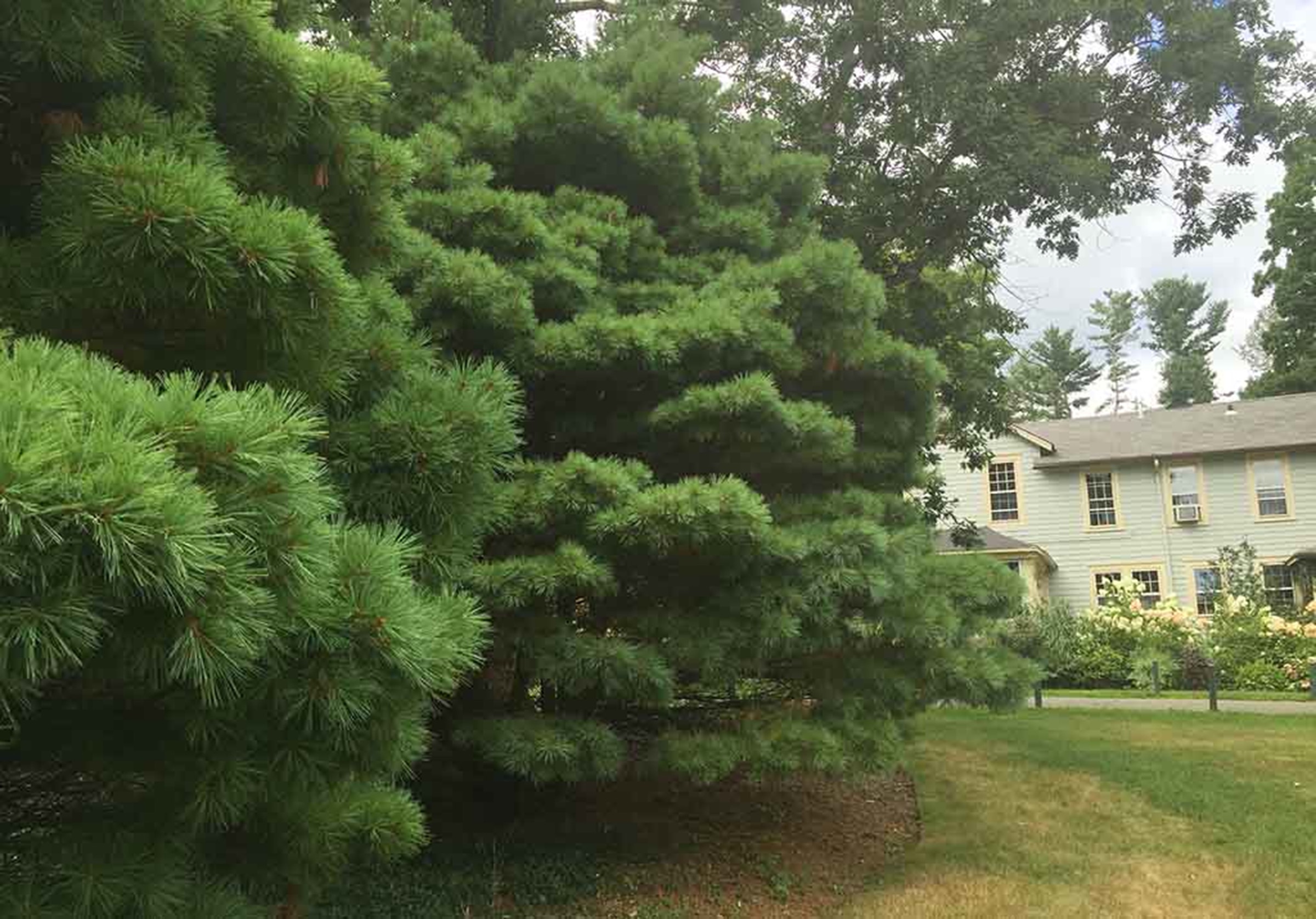
Witches' Broom Collection
A witches’- broom is a characteristic of some coniferous evergreens. It is an abnormal growth of dense, darker green foliage near the inner truncated branches that mound into a form similar to representations of witches’ brooms. They can be caused by a natural mutation or by a parasite or virus that causes the natural growth to mutate. Dr. Sidney Waxman, a noted University of Connecticut horticulturist who studied this, developed several varieties from seedlings and donated 12 of them in the early 1980s, adding to a small collection already at the Arboretum. His donated brooms were all mutants of White Pine (Pinus strobus).
-

Cottage Garden
Named for the popular British gardens in the 18th century, ours sat behind a cottage built in 1934, which was sadly destroyed by Hurricane Sandy in 2012. This garden now sits in front of the Homestead Building.
The garden plants enjoy both sun and shade, beginning in spring with the hellebores (Helleborus spp.) and finishing the growing season with a display of Japanese Toad Lilies (Tricyrtis hirta) and chrysanthemums. Its contents can evolve over the years to adapt to changing conditions, offering glimpses into the rich, changing history of the Bartlett.
-
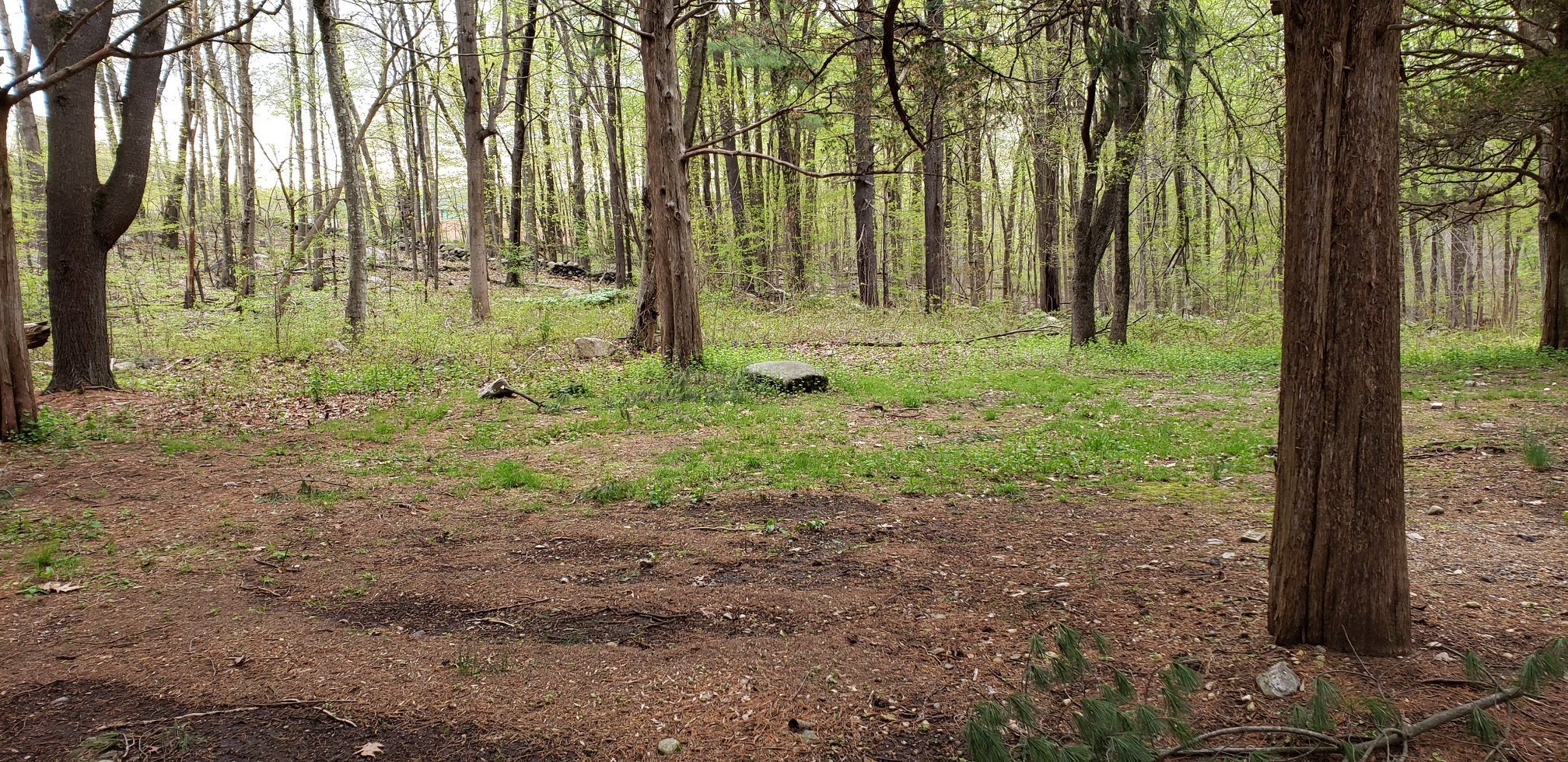
Potter's Field
Potter’s Field, located between Cemetery Trail and Scofield Magnet Middle School’s soccer field, is where Stamford’s indigent were buried for a century until 1970. Since the 1990s, a group of interested volunteers have been uncovering grave markers - small concrete blocks marked with numbers - and studying the history and identification of those buried here. An effort was led in 1997 to clear and help restore the grounds that had fallen into neglect since the cemetery’s closure.
-

Native Plant Shade Garden
The flowering plants, shrubs, and ferns featured in this garden are native to the northeast. These varieties existed in the region when European settlers first arrived and co-evolved with local insects, birds and other animals to form an interdependent community. They are ideal for any ecologically balanced garden, as they require limited resources and attract and support native pollinators. Read more:
-
Kate and Robert Bartlett Jr. Magnolia Collection
The Bartlett family has continued their interest in the Arboretum and their contributions to the collections established by F. A. Bartlett more than 100 years ago. One of the early plantings was Southern Magnolia (M. grandiflora), which Bartlett planted on the side of the Homestead. It had giant white flowers and evergreen leaves. It suffered damage, probably due to marginal hardiness, and was removed in 1979. Robert Bartlett Jr. has a keen interest in magnolias and has provided the Arboretum with several new hybrids in recent years. The collection has grown to more than 40 cultivars of magnificent Star Magnolias (M. stellata), Chinese Magnolias (M. sinensis), and Saucer Magnolias (M. x soulangeana).
-

Perennial Border
Three perennial gardens are featured at the Arboretum. The Border, which began in the 1970s as an iris display garden by the Iris Society in Stamford is 140 feet long and approximately 14 feet wide. In the early 1980s, it started to evolve under the directorship of Ted Lockwood (who served in the position from 1979 to 1987) as tired bulbs were replaced with colorful perennials.
Today, it’s packed with more than 100 varieties of plants, paying close attention to natives and a shady/sunny mix depending on where they are situated in the garden. The garden attracts pollinators and is a source of nourishment or host for their eggs. It is designated as a Monarch Waystation. The border takes care of itself with only a weekly weeding and infrequent watering. High maintenance plants are avoided. Meticulous attention is paid to the arrangement of color and texture, so that every season offers a different visual tapestry.
-
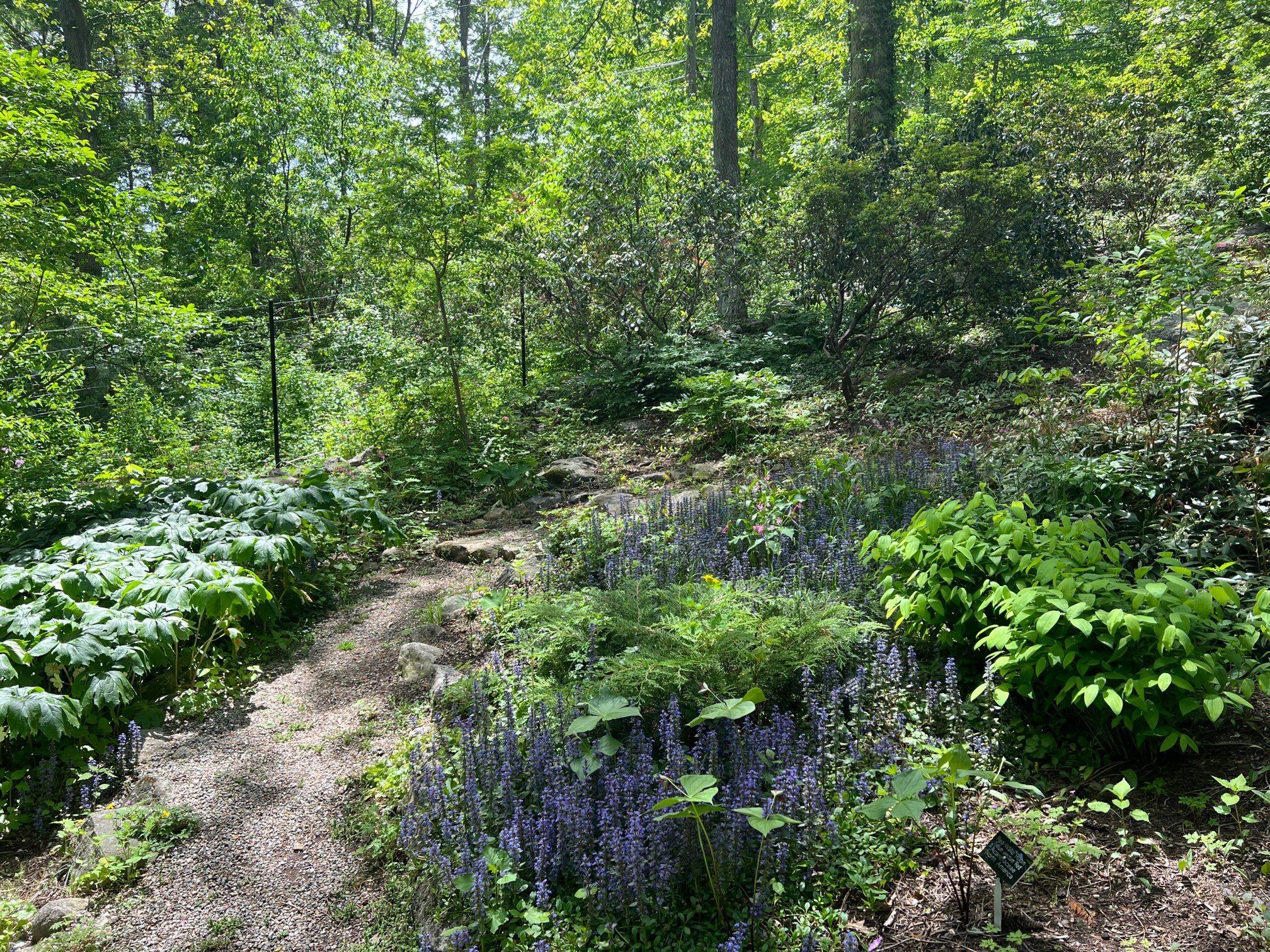
Jane B. Heisinger Wildflower Garden
Explore the Jane B. Heisinger Wildflower Garden, located next to the Linda Nykaza Albanese Herb Garden. Filled with more than 100 local species on about one quarter of an acre, this garden represents the diversity of attractive native plants that can be used for the home landscape. It was established as a living memorial to Francis Bartlett's daughter, Jane Bartlett Heisinger who passed away in 1991. This garden emphasizes that native plants are important to the local ecosystem because they provide sustenance and habitat for native insects, bees, butterflies, birds, and animals. Some of the noted plants in this garden are Virginia Bluebells (Mertensia virginica), Trout Lilies (Erythronium americanum), Mayapples (Podophyllum peltatum), Black Cohosh (Actaea racemosa), and Jack-in-the-Pulpit (Arisaema triphyllum).
-

Fruit and Vegetable Garden
When the Bartlett family lived on the property, this sunny walled-in garden was the site of many lively parties. In 2008, the vegetable and fruit garden was established in this site, behind the Greenhouse, with decoratively arranged raised garden beds, pathways, ornaments, espaliered fruit trees, fruiting shrubs, and a variety of vegetables. The garden is completely organic with directly sown seeds as well as sets planted in the spring. Natural amendments such as egg shells, banana peels, and seaweed are used to encourage growth, and insects are deterred with companion plants such as garlic, onions, and marigolds. Many flowers are grown to attract pollinators and beneficial insects. Our perennial and seasonal vegetables serve the community as a source of education and vegetable gardening throughout the region.
-

Pinetum
A large grouping of needled evergreens, including pines, spruces, true cedars, false cypress, and hemlocks is clustered near the edge of the cultivated grounds, and is known as the Pinetum. Among the more magnificent specimens originally found there is the Cedar of Lebanon (Cedrus libani), a grand tree with broad branching and a thick trunk. In recent years, it has been damaged by storms and is overshadowed by the Japanese Umbrella Pines (Sciadopitys verticillata)(left) with needles that diverge around the stem giving it an “umbrella” effect and Weeping Hemlock (Tsuga canadensis ‘Pendula’)(right), which is a splendid example of a graceful pendulous conifer.
-

Herbarium
A herbarium is a collection of plant samples and associated data that has been preserved for long-term study. These samples may include pressed and mounted plants or plant parts, seeds, dry and fluid-preserved flowers or fruits, pollen, sections of wood, and frozen plant DNA. The stored samples are referred to as herbarium specimens.
In addition, herbaria (plural for herbarium) also store and manage botanical data sets, illustrations, photographs and slides, maps, and other relevant literature useful to researchers when studying the specimens.
Herbarium specimens are used to study plant taxonomy, geographic distributions, and for plant identification. They also serve as a historical record of vegetation changes over time. In some cases, herbaria may contain the only specimens of plants that have become extinct or have mutated due to changes in climate and the impact of humans in their environment.
The Bartlett Arboretum Herbarium is located in the lower level of the Silver Educational Center and holds specimens from as far back as 1887. The herbarium contains vascular plants and bryophytes from throughout the world with a concentration on the greater New York City area, southwestern Connecticut, Florida, Puerto Rico, Arizona and Amazonian Peru. Many of the specimens are native to Connecticut and have been collected from the arboretum grounds.
In 2009, the herbarium received its Index Herbariorum acronym (BART), identifying it as a valuable resource to the research and educational community and supporting and validating the history and mission of the Bartlett Arboretum & Gardens.
Please click here for a digitized list of the plant specimens found in the Bartlett Arboretum Herbarium.
The Herbarium is open by appointment. Please call 203-883-4052 for information.
-
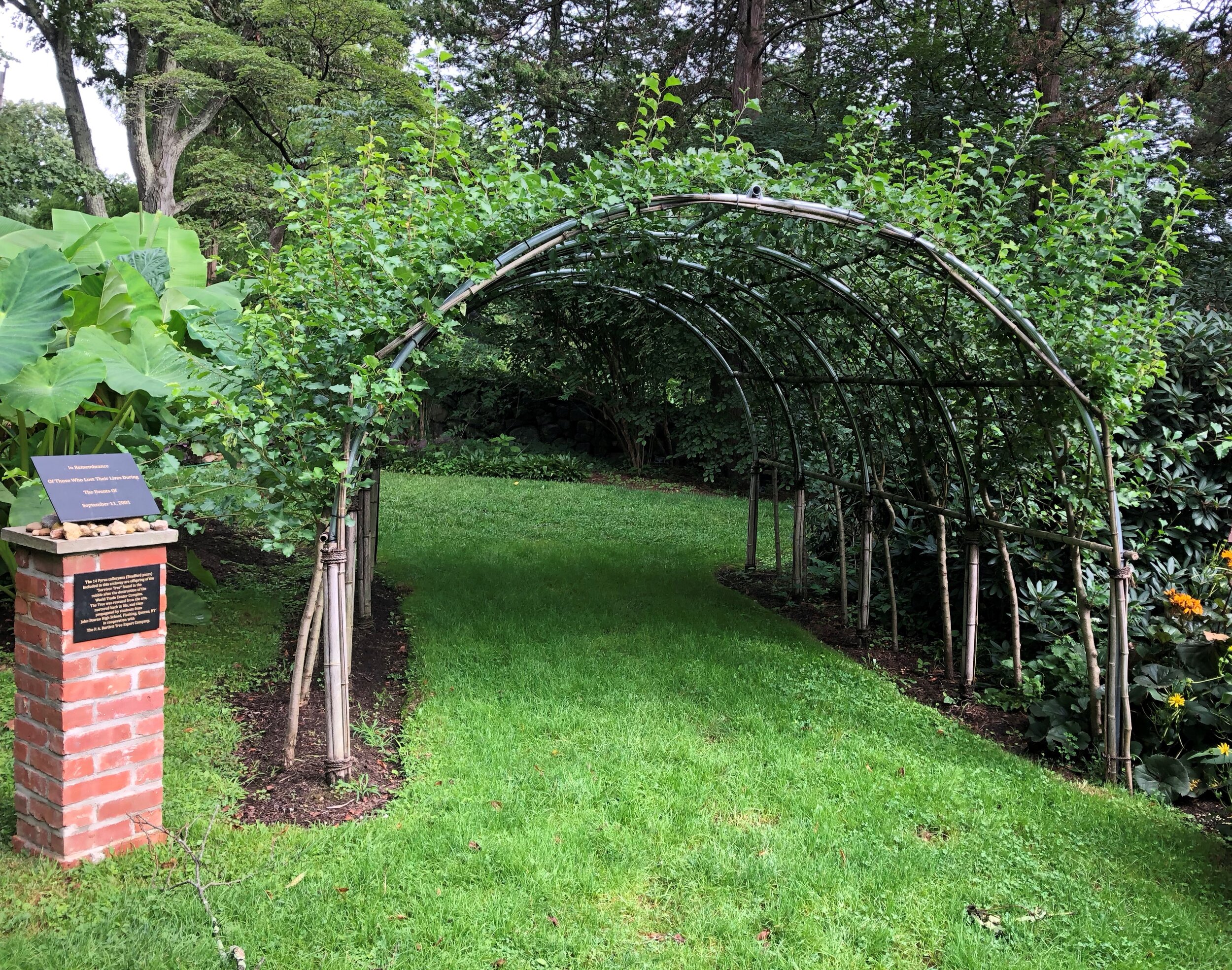
9/11 Memorial “Survivor Tree” Archway
In 2015, a 16-foot “Survivor Tree” archway at the Bartlett Arboretum & Gardens was constructed with the collaboration of The F. A. Bartlett Tree Expert Company and the 9/11 Memorial & Museum in New York City.
The “Survivor Tree,” a Bradford callery pear (Pyrus calleriana ‘Bradford’), was found alive amidst the rubble, during the recovery efforts at the World Trade Center. The tree was replanted at the National September 11 Memorial & Museum. Students from John Bowne High School in Flushing, Queens, took cuttings from the tree, 14 of which were planted in a memorial archway on the Arboretum property.
The 16 foot x 12 foot x 8 foot archway was made of metal and bamboo over which the 14 World Trade Center “Survivor Tree” offspring trees were trained to create a canopy tunnel. An artifact from the rubble was also brought in and mounted at the entrance of the archway. The trees were gifted to The F. A. Bartlett Tree Expert Company by the 9/11 Memorial & Museum as a thank you for their benevolence and continued care and commitment to the “Survivor Tree” and the Survivor Tree Seedling program. The F. A. Bartlett Tree Expert Company then helped construct this living memorial dedicated to those who lost their lives during the attacks on September 11, 2001.
The offspring trees continue to mature and are tagged with numbered gold medallions that identify each, and, like the Survivor Tree, they continue to serve as landmarks symbolizing resilience and hope.
-

Word Garden
Thanks to a generous donation from the Pitney Bowes Foundation, our Word Garden, which can be found on the Great Lawn, gives visitors the opportunity to create poetry, share a message or start a discussion. Please leave your words for others to enjoy!
-

Sundial Garden
This garden hosts a sundial and one of the best vistas of the Arboretum. It can be found on the Great Lawn, between the Word Garden and the Greenhouse. It has full sun exposure, so all the plants in the garden can be considered drought tolerant and fairly deer resistant. Many of the plants have been chosen for attracting birds, butterflies, and bees in the area.
-
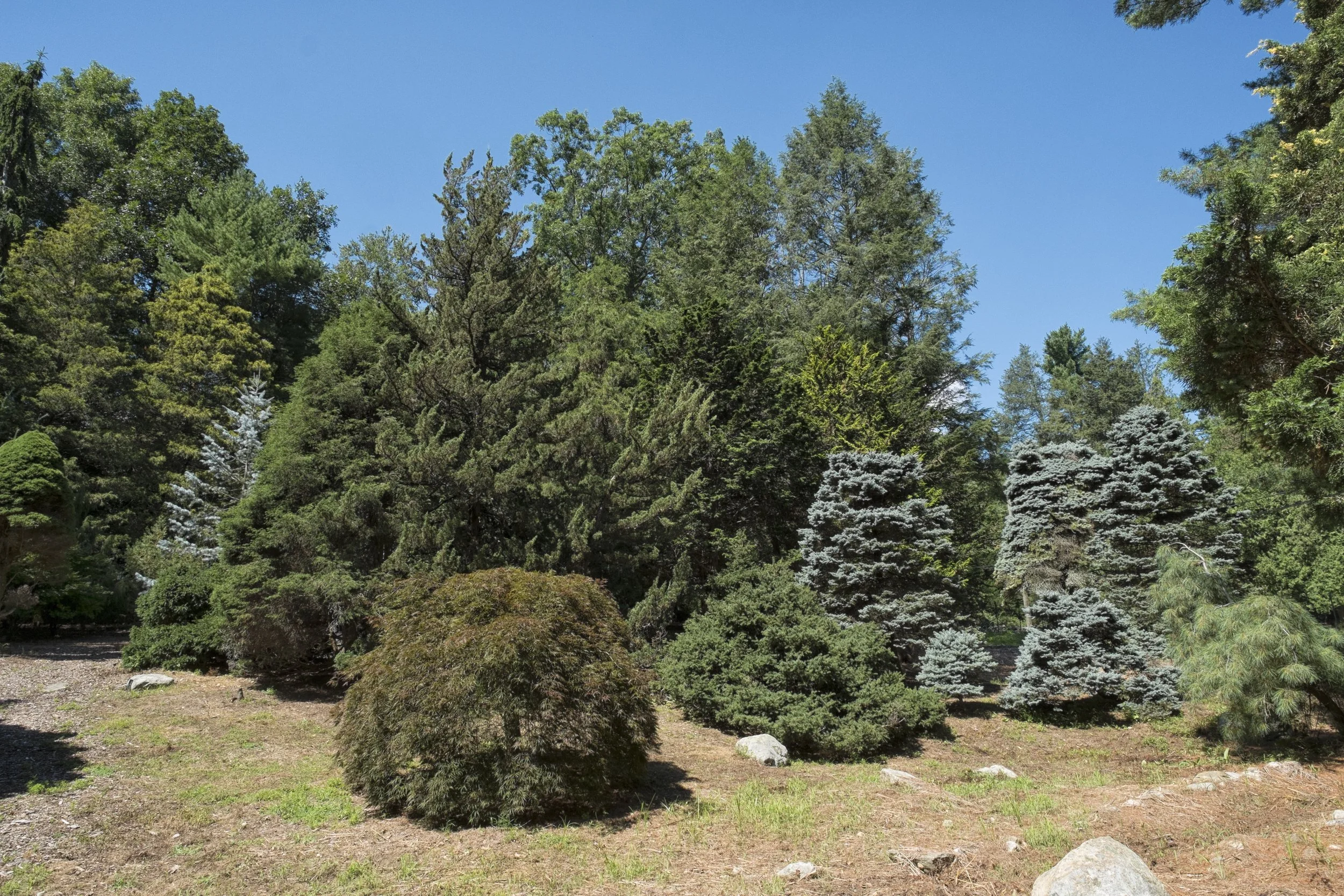
Frank Bartlett Heisinger Conifer Garden
This garden is located across the street from the Homestead Building. The original 250 plants comprising 150 species of dwarf conifers have culled themselves over the years, but the aesthetic intent is unsurpassed even with the reduced number of plants. The architect used a synoptic arrangement, grouping plants of each genus together. The other striking point to note is that dwarfs do not stay small; while they grow very slowly, some as little as an inch in a year, the garden’s plants are hardly small in stature some 50 years after they were first planted. Recently, the addition of two contiguous acres will allow for a rebirth of the dwarfs as plans are underway to develop the new property. The juxtaposition of the fully grown dwarf conifers with the newly planted ones will create a remarkable contrast. It is hoped that it will become a reference garden for dwarf conifer connoisseurs the world over.
-
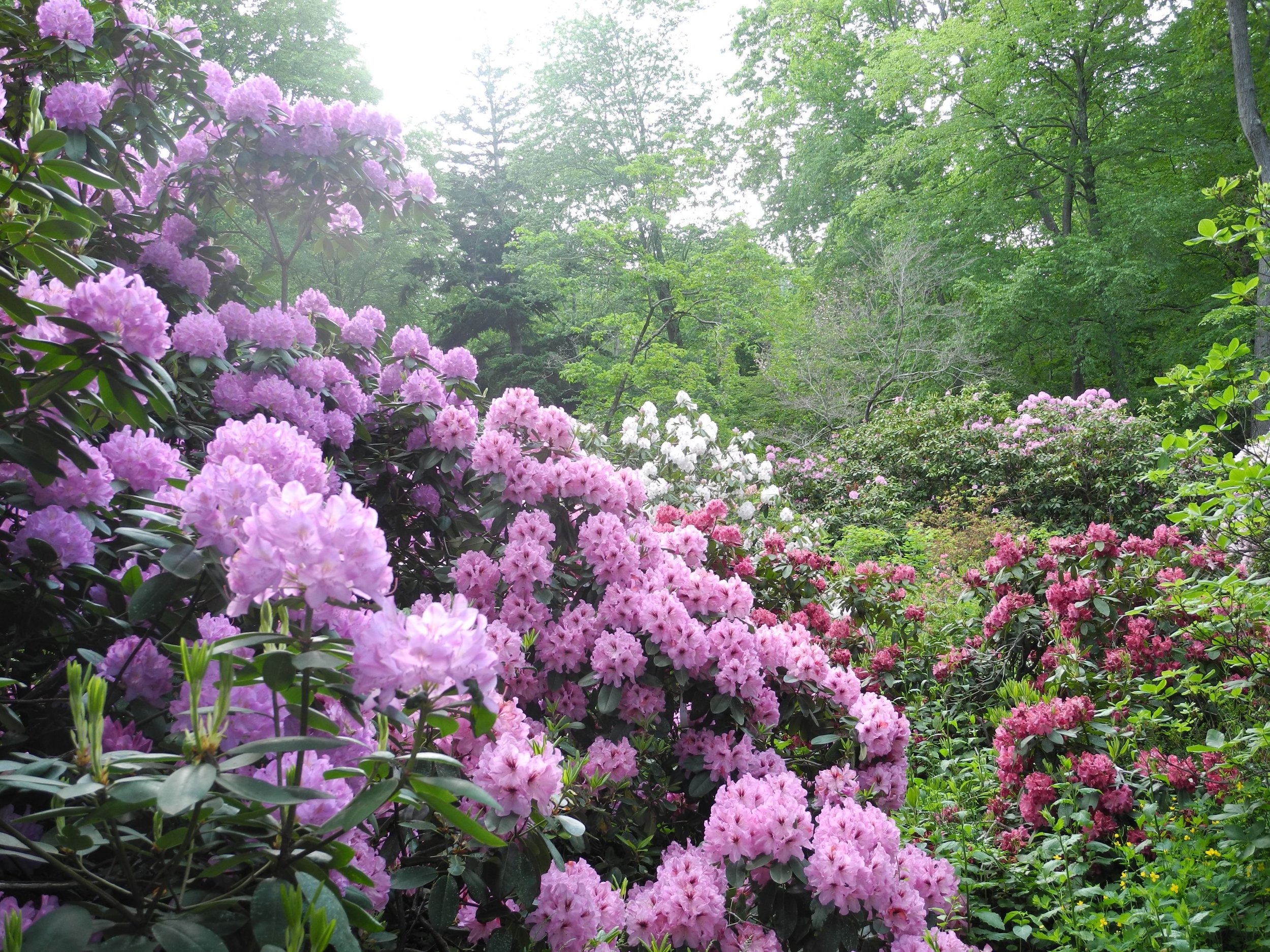
Mehlquist Garden
In 1966, the so-called Ericaceous Area no. 1 was established by Dr. Gustav Mehlquist, a noted plant breeder at the University of Connecticut. He developed a rough map for the records of several hundred plants in 15 sections defined by a system of paths. Since this inauspicious beginning, several employees and volunteers have taken on the task to map and remap the Garden, which was dedicated to Dr. Mehlquist years later. He is credited with developing hardy high quality rhododendrons and azaleas, but the garden is also home to Highbush Blueberries, Japanese Andromeda, Enkianthus, and Mountain Laurel, the Connecticut state flower, under the canopy of several hardwood trees.
-

Alice Smith Fern Allée
This pathway is bordered on each side by more than 60 varieties of ferns, which thrive with other shade-loving plants. The woodlands and wetlands of the Arboretum are speckled with at least 22 varieties of native ferns. Since they were far from accessible trails, this special area was created to showcase non-natives alongside natives. As ferns are unfolding their fronds, they are known as fiddleheads. Ferns are among the oldest plant forms, dating back as far as 350 million years. Our collection includes the Tatting Fern (Athyrium filix-femina ‘Frizelliae’), the Christmas Fern (Polystichum acrostichoides), and the Upside-down Fern (Arachnoides standishii), among others.
-
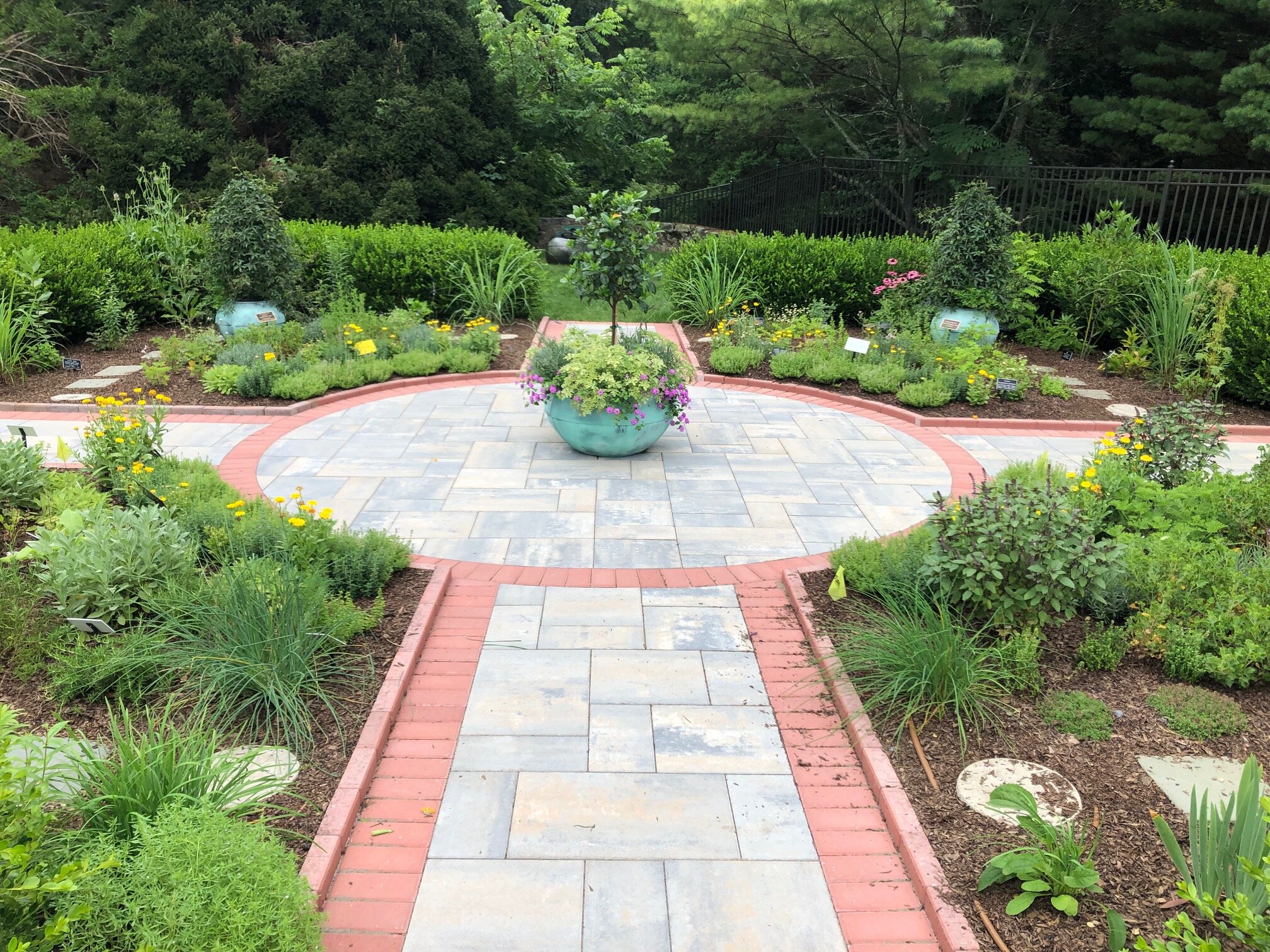
Linda Nykaza Albanese Herb Garden
The Herb Garden includes four classic quadrants which will charm the visitor with aromatic, culinary, medicinal, and economically interesting herbs. The plants are annual and perennial, native and tropical, flowering in all seasons with more than 100 species in a compact setting sure to delight the senses. Herbs are products we use every day in teas, medicines, and flavorings. The culinary section offers herbs like basil and French tarragon to flavor food. The aromatic section features fragrant herbs used in perfumes and essential oils. Applied correctly, the herbs in the medicinal section can treat indigestion, colds, and migraines. Food additives, dyes, and fibers are featured in the economic quadrant. Read about the renovations we made to our Herb Garden in 2021, thanks to a team of volunteers and donors.
-
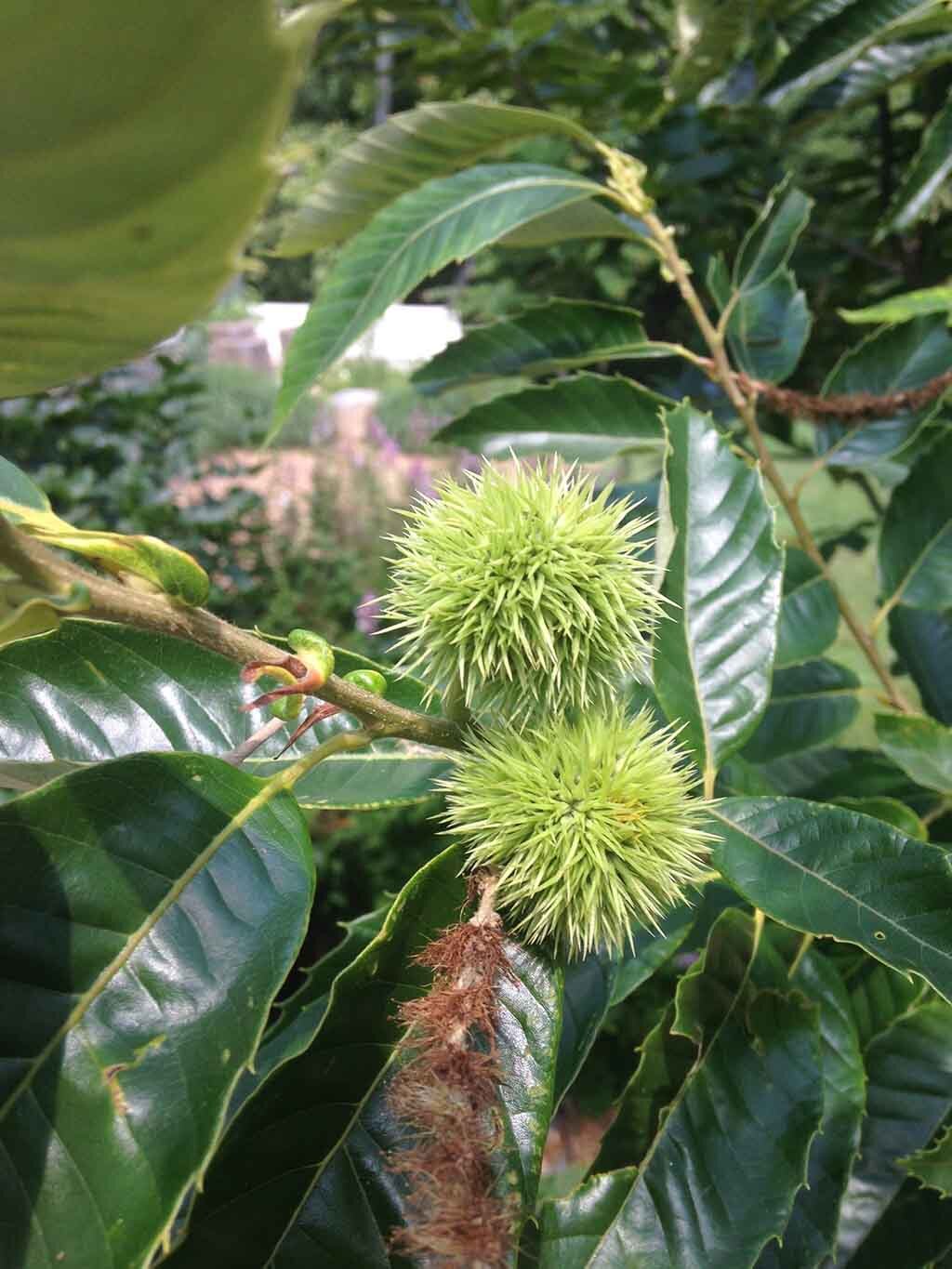
Nut Tree Collection
Dr. Bartlett was especially enamored of nut trees and several of his plantings remain to this day. Pecans, Walnuts, Butternuts, the Heartnut, and Horsechestnuts are scattered about the property.
-

Laurel Collection
Connecticut’s state flower, Mountain Laurel (Kalmia latifolia), is well represented at the Arboretum with as many as 150 different forms of the plant on the grounds dating back to 1971. Two other natives thrive as well: Sheep Laurel (K. angustifolia) and Eastern Bog Laurel (K. polifolia). They can be found in the Conifer Garden and around the main house. Native laurels have white to pink flowers, and broadleaf evergreen leaves. Mountain Laurel can get very large when grown in the right conditions, while Sheep Laurel remains low-growing (1 to 3 feet). Bog Laurel is a very small plant, barely reaching two feet, with hot pink flowers, found growing near wet areas. Many of the Arboretum specimens were donated by Dr. R. A. Jaynes, former plant geneticist at the Connecticut Agricultural Experiment Station in New Haven.
Sensory Garden
Our Sensory Garden is the newest garden at the Bartlett, located next to the Silver Educational Center. It is devoted to plants that emphasize the five senses: sight, smell, hearing, taste, and touch. Each raised bed in the garden has a different group of plants. For instance, the SMELL bed has scented plants like lavender, roses, scented geraniums, and lilies. The HEARING bed has a fountain and grasses and bamboos that make noise when the wind blows. The TASTE bed has ripe sugar snap peas, beans, oregano, basil, and cherry tomatoes-Yes! Please taste!
The Garden is accessible to all with ADA-approved measurements for wheelchairs and walkers, two new handicapped parking spaces, benches, and braille signage. It provides programming for those with disabilities, autism, and those in need of a calm, but stimulating experience in the garden.

